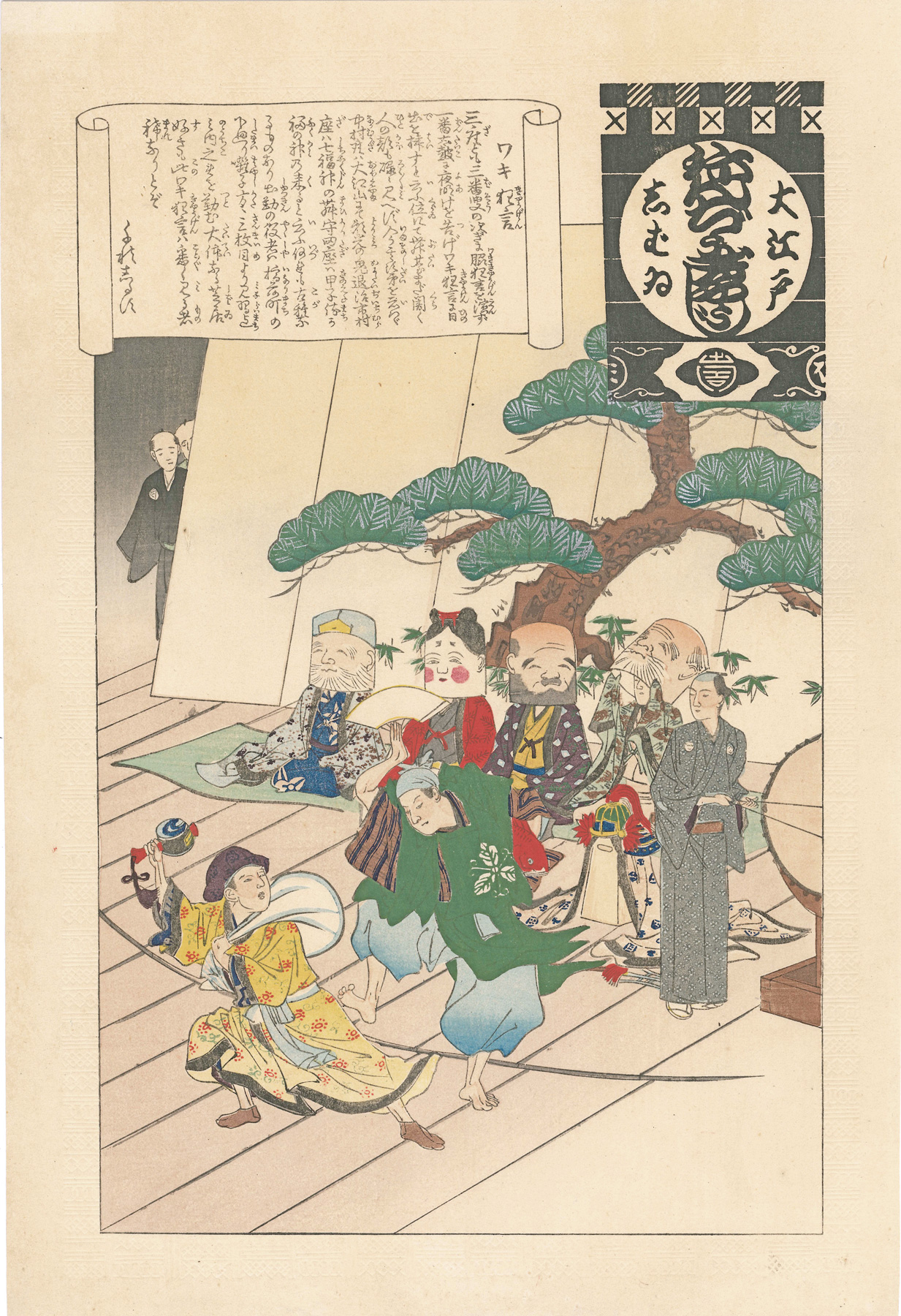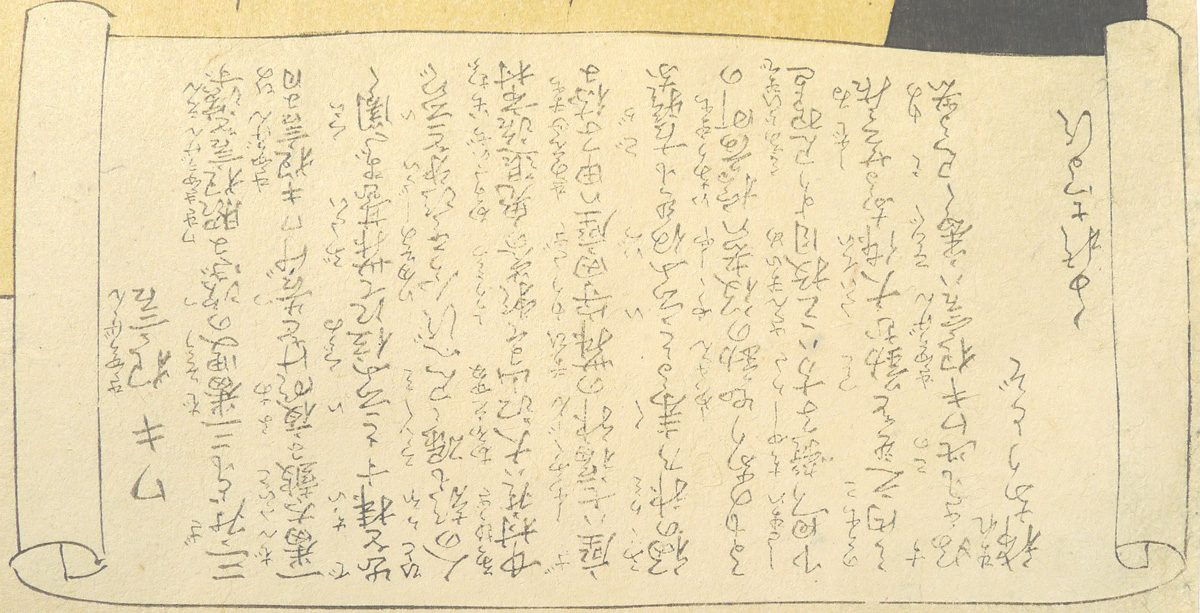About This Print
This print, part of a series of twenty-five prints (plus a prolog/index print) picturing events in a typical year in an Edo theater, depicts an annual waki kyogen performance starting at dawn, announced by the banging of the large drum, consisting of auspicious dances such as the Dance of the Seven Lucky Gods and the Sanboso dance. Reference is made in the scroll to both the Ichimura-za and Nakamura-za theaters in Edo.
Waki kyōgen are old pieces from kabuki's earliest days. Each theatre had its own play, and it was performed early in the morning, around sunrise, after the first piece, Sanbasō. Played by the lowest-level apprentice actors known as inarimachi, together with trainee musicians, it was both a ceremonial piece and one that offered young actors opportunities for stage practice. In this print, we see a performance of the play Shichi fukujin (Seven Lucky Gods) at the Ichimura Theatre. The waki kyōgen for the Nakamura Theatre was Shuten Dōji, and at the Morita Theatre, it was Kōshimachi. The music and movements for Shichi fukujin have been passed down, but Shuten dōji has disappeared, and only the music remains for Kōshimachi. In Kamigata (Ōsaka and Kyoto), theatres didn't have characteristic waki kyōgen. Pieces were chosen to accord with the season, generally taking their subject matter from Mibu kyōgen (a performing art associated with this area).
The old style of kabuki remains in performances of waki kyōgen: the stage is made to resemble an early-period stage, that is, a noh stage; a fusuma (papered frame used as a sliding door) with painted pine branches is erected in the place of the kagamiita (the back wall of the noh stage, which is always decorated with a pine tree); and the musicians come out to play on stage. Related to this last point, the large drum and its player are depicted in this print, as well as the informally-dressed men poking their heads around the side of the fusuma to sing the nagauta music.
About This Series
Source: Tokyo Metropolitan Library http://www.library.metro.tokyo.jp/Portals/0/edo/tokyo_library/english/modal/print.html?d=20; ARC http://www.arc.ritsumei.ac.jp/lib/vm/kabuki2015_e/2015/11/oedo-shibai-nenjyu-gyoji.html and from personal observation.
Ōedo Shibai Nenjū Gyōji (Annual Events of the Edo Theater) drawn by Adachi Ginko [with two prints, Yomitate (Public Reading) and Saruwaka Kyōgen (IHL Cat. #2015), contributed by Torii Kiyosada (1844-1901)] is a set of twenty-six prints (including an index/prologue page), depicting the manners and customs relating to Kabuki plays/theaters in the Saruwaka-chō, the Kabuki theater district which flourished until 1867, the first year of the Meiji Era. The Ritsumeikan Art Research Center posits that this series was issued in response to the public's "remarkable nostalgia for [the] Edo period, the 'Great Tokugawa Epoch'." It goes on to say that this series is a continuation of the many earlier Kabuki theater guidebooks which "introduce[d] not only about things on a stage but also properties, organization of theatres and backstage."
Three Editions
At least three editions of this series were released. One edition, likely the first edition, contains the publisher's name, Hasegawa Sumi, and associated publishing and printing information along the left margin. This first edition, with the publishing information, is often found bound into volumes, with the margins of the prints trimmed back. My guess is that these bound volumes were created by the publisher. Another edition, likely a second edition, uses an embossed border around the entire image which is not present on the earlier edition. Generally these second edition prints have wider margins than the first edition. It is possible that these second edition prints were sold by subscription. A third edition, which appears to be printed from new blocks, as differences in composition in each print can be seen, is a less elaborate printing than the earlier editions. Interestingly, this later edition uses the convention called komochiki of a thick notched line and thin black line framing the subjects, a popular Edo textile pattern thought to reflect iki taste (Edo chic). Use of this type of framing is associated with kōkanfuda, a type of votive offering print. (See IHL Cat. #1686 A Set of Three Nōsatsu Kōkanfuda - Fūjin the Wind God, Raijin the Thunder God, Calligraphic Cover Sheet for more information about kōkanfuda.)
Summary of Differences Between the Three Editions
1. First edition prints contain the publishing and printing information, including dates, along the left margin. In the later edition of prints only the Index/Prologue print contains any publishing information, with the publishing house 長谷川 板 (Hasegawa han), proceeded by the publisher's address embossed in the lower left corner. No date is given on this print or any other later edition prints.2. Most first edition prints contain the artist's signature and/or seal. Later editions do not carry the artist's signature or seal.3. Second edition prints contain an approximately 1/2" wide embossed border around the entire image area not present on the first edition.4. Some second edition prints may have had the original blocks reworked.5. Third edition prints were printed from new blocks and all have a thick notched line and thin black line framing the subjects.
At least three editions of this series were released. One edition, likely the first edition, contains the publisher's name, Hasegawa Sumi, and associated publishing and printing information along the left margin. This first edition, with the publishing information, is often found bound into volumes, with the margins of the prints trimmed back. My guess is that these bound volumes were created by the publisher. Another edition, likely a second edition, uses an embossed border around the entire image which is not present on the earlier edition. Generally these second edition prints have wider margins than the first edition. It is possible that these second edition prints were sold by subscription. A third edition, which appears to be printed from new blocks, as differences in composition in each print can be seen, is a less elaborate printing than the earlier editions. Interestingly, this later edition uses the convention called komochiki of a thick notched line and thin black line framing the subjects, a popular Edo textile pattern thought to reflect iki taste (Edo chic). Use of this type of framing is associated with kōkanfuda, a type of votive offering print. (See IHL Cat. #1686 A Set of Three Nōsatsu Kōkanfuda - Fūjin the Wind God, Raijin the Thunder God, Calligraphic Cover Sheet for more information about kōkanfuda.)
Print Details
| IHL Catalog | #673; #1612 |
| Title or Description | Waki kyōgen ワキ狂言 (Auspicious plays) |
| Series | Annual Events of the Edo Theatre ((Ō-Edo shibai nenjū-gyōji 大江戸しばゐねんぢうぎやうじ) |
| Artist | Adachi Ginkō (active 1874 – 1897) |
| Signature | Ginkō 吟光 |
| Seal | Ginkō |
| Publication Date | #673: 1897 (Meiji 30), January 11 明治三十年一月十一日印刷仝年一月十五日発行 #1612: The original publication date of the first edition is 1897. The publication date of this second edition print, is unknown. |
| Publisher |  #1612: no publisher's seal shown, but Index/Prologue sheet from the later edition contains an embossed seal reading 長谷川 板 (Hasegawa han). |
| Carver | unknown |
| Printer | |
| Impression | #673 and #1612: excellent |
| Colors | #673 and #1612:excellent |
| condition | #673: good - slightly trimmed; backed with heavy album paper #1612: good - light toning |
| Genre | ukiyo-e; yakusha-e |
| Miscellaneous | IHL Cat. #673: The two square seals, shown left, are associated with a number of publishers during the 1890s, including the publishers Hasegawa Sumi 長谷川寿美 and Komori Sōjirō 小森宗次郎. They often appear near the publisher's name. Taken together, the seals read Kumiai seigen 組合正言. Kumiai can be translated as "guild" and seigen can be translated as "censor" (using the Chinese meaning for the word.) So, we may have some type of publisher's guild approval or censor seal. The two square seals, shown left, are associated with a number of publishers during the 1890s, including the publishers Hasegawa Sumi 長谷川寿美 and Komori Sōjirō 小森宗次郎. They often appear near the publisher's name. Taken together, the seals read Kumiai seigen 組合正言. Kumiai can be translated as "guild" and seigen can be translated as "censor" (using the Chinese meaning for the word.) So, we may have some type of publisher's guild approval or censor seal. |
| Format | vertical ōban |
| H x W Paper | #673: 14 x 9 1/4 in. (35.6 x 23.5 cm) #1612: 15 3/4 x 10 13/16 in. (40 x 27.5) |
| H x W Image | #673: 13 11/16 x 9 1/16 in. (34.8 x 23 cm) #1612: 13 11/16 x 8 15/16 in. (34.8 x 22.7 cm) |
| Literature | |
| Collections This Print | British Museum 1983,0523,0.3.5; Waseda University Cultural Resource Database 201-0205 and 201-0702; Museum of Fine Arts Boston RES.53.22; National Diet Library 1309615; Edo-Tokyo Museum (Tokyo Digital Museum 91970050); Tokyo Metropolitan Library 577-010-05; Art Research Center, Ritsumeikan University AcNo.国会456-00-005 |




